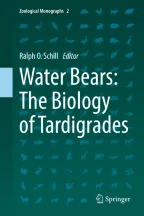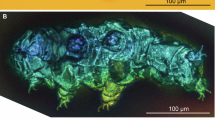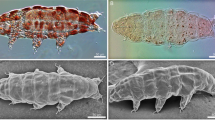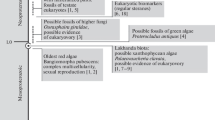Abstract
Few fossil tardigrade records are known, probably due to their minute size and absence of consistent hard body parts. A possible but not certain tardigrade ancestor was found as an “Orsten”-type secondarily phosphatized fossil from the Middle Cambrian limestone. It is characterized by only three pairs of legs as a possible consequence of a plesiomorphic anameric ontogeny that led to four leg segments in the extant tardigrades. Its other characters, related to claw and cuticle morphologies, resemble those of heterotardigrades. The first findings of sure tardigrades come from Cretaceous amber, in which the species Beorn leggi and Milnesium swolenskyi were found. These species, and especially the latter, evidence that more than 90 million years ago, “modern” tardigrades already existed, and only few morphological differences, mainly related to morphometric tracts, occur with respect to known modern species. Quaternary subfossils of tardigrades have been found with palynological studies during paleoecology researches. They have been recorded mainly in polar regions and classified within the non-pollen palynomorphs category. Cuticular remains of animals and eggs can persist in the substrates for very long time, so tardigrades can be used as paleoclimatic bioindicators, but despite their potentiality, a few studies have focused to find these organisms in microfossil samples and in sediments for paleoecological studies.
For estimating the dates of phylogenetic events related to the origin of tardigrades and/or their evolutionary lineages, molecular clock analyses have been used. Molecular data indicate that the origin of the phylum should be posed during or before the Cambrian period, placing the origin of Tardigrada in marine environment and their terrestrialization not before that of other ecdysozoans.
Access this chapter
Tax calculation will be finalised at checkout
Purchases are for personal use only
Similar content being viewed by others
References
Bernardová A, Košnar J (2012) What do Holocene sediments in Petuniabukta, Spitsbergen reveal? Pol Polar Res 33:329–345
Bertolani R, Grimaldi D (2000) A new Eutardigrade (Tardigrada: Milnesiidae) in amber from the upper cretaceous (Turonian) of New Jersey. In: Grimaldi D (ed) Studies on fossils in amber, with particular reference to the cretaceous of New Jersey. Backhuys, Leiden, pp 103–110
Blouin C, Butt D, Roger AJ (2005) Impact of taxon sampling on the estimation of rates of evolution at sites. Mol Biol Evol 22(3):784–791
Caron JB, Aria C (2017) Cambrian suspension-feeding lobopodians and the early radiation of panarthropods. BMC Evol Biol 17(1):29
Chen JY, Zhou GQ (1997) Biology of the Chengjiang fauna. Bull Natl Mus Nat Sci 10:11–106
Cooper KW (1964) The first fossil tardigrade: Beorn leggi Cooper, from cretaceous amber. Psyche 71:41–48
Cromer L, Gibson JAE, Swadling KM, Hodgson DA (2006) Evidence for a lacustrine faunal refuge in the Larsemann Hills, East Antarctica, during the last glacial maximum. J Biogeogr 33:1314–1323
Cromer L, Gibson JAE, McInnes SJ, Agius JT (2008) Tardigrade remains from lake sediments. J Paleolimnol 39:143–150
Durante MV, Maucci W (1972) Descrizione di Hypsibius (Isohypsibius) basalovoi sp. nov. e altre notizie su Tardigradi del veronese. Mem Mus Civ St Nat Verona 20:275–281
Erwin DH, Laflamme M, Tweedt SM, Sperling EA, Pisani D, Peterson KJ (2011) The Cambrian conundrum: early divergence and later ecological success in the early history of animals. Science 334:1091–1097
Feng DE, Cho G, Doolittle RF (1997) Determining divergence times with a protein clock: update and reevaluation. PNAS 94:13028–13033
Gibson JA, Cromer L, Agius JT, McInnes SJ, Marley NJ (2007) Tardigrade eggs and exuviae in Antarctic lake sediments: insights into Holocene dynamics and origins of the fauna. J Limnol 66(Suppl 1):65–71
Guidetti R, Rebecchi L, Bertolani R (2000) Cuticle structure and systematics of the Macrobiotidae (Tardigrada, Eutardigrada). Acta Zool 81(1):27–36
Guidetti R, Rebecchi L, Cesari M, McInnes SJ (2014) Mopsechiniscus franciscae, a new species of a rare genus of Tardigrada from continental Antarctica. Polar Biol 37(9):1221–1233
Guidetti R, McInnes SJ, Cesari M, Rebecchi L, Rota-Stabelli O (2017) Evolutionary scenarios for the origin of an Antarctic tardigrade species based on molecular clock analyses and biogeographic data. Contrib Zool 86(2):97–100
Kristensen RM, Neuhaus B (1999) The ultrastructure of the tardigrade cuticle with special attention to marine species. Zool Anz 238:261–282
Jankovská V (1992) Unbekannte Objekte in Pollenpräparaten – Tardigrada. In: J Kovar-Eder (ed) Palaeovegetational development in Europe and regions relevant to its palaeofloristic evolution. Proceedings of the Pan-European Palaeobotanical Conference, Museum of Natural History, Vienna, pp 19–23, 19–23 Sept 1991
Jankovská V (2008) Non pollen Palynomorphs in Pollen slides: their determination and utilization in palaeoecology. Новости палеонтологии и стратиграфии: Приложение к журналу 10–11:488–491
Jankovská V, Roszkowska M, Kaczmarek Ł (2016) Remains of non-pollen-palynomorphs–tardigrades from Spitsbergen found during pollen analyses. Polar Rec 52(04):450–463
Jørgensen A, Faurby S, Hansen JG, Møbjerg N, Kristensen RM (2010) Molecular phylogeny of Arthrotardigrada (Tardigrada). Mol Phyl Evol 54(3):1006–1015
Liu J, Steiner M, Dunlop JA, Keupp H, Shu D, Ou Q, Han J, Zhang Z, Zhang X (2011) An armoured Cambrian lobopodian from China with arthropod-like appendages. Nature 470(7335):526–530
Maas A, Waloszek D (2001) Cambrian derivatives of the early arthropod stem lineage, pentastomids. tardigrades and lobopodians Zool Anz 240:451–459
Maas A, Mayer G, Kristensen RM, Waloszek D (2007) A Cambrian micro-lobopodian and the evolution of arthropod locomotion and reproduction. Chin Sci Bull 52(24):3385–3392
Miller WR, Heatwole HF (2003) Tardigrades of the sub-Antarctic: 5000 year old eggs from Marion Island. Abstract. 9th International Symposium on Tardigrada, Florida, USA
Müller KJ, Walossek D, Zakharov A (1995) “Ortsen” type phosphatized soft-integument preservation and a new record from the middle Cambrian Kuonamka formation in Siberia. N Jb Geol Paleont Abh 197:101–118
Nabhan AR, Sarkar IN (2012) The impact of taxon sampling on phylogenetic inference: a review of two decades of controversy. Brief Bioinform 13(1):122–134
Nei M, Xu P, Glazko G (2001) Estimation of divergence times from multiprotein sequences for a few mammalian species and several distantly related organisms. PNAS 98(5):2497–2502
Nielsen C (2012) Animal evolution: interrelationships of the living phyla, 3rd edn. Oxford University Press, New York
Peterson KJ, Cotton JA, Gehling JG, Pisani D (2008) The Ediacaran emergence of bilaterians: congruence between the genetic and geologic fossil records. Philos T Roy Soc B 363:435–1443
Pilato G (1979) Correlations between cryptobiosis and other biological characteristics in some soil animals. Boll Zool 46:319–332
Regier JC, Shultz JW, Kambic RE, Nelson DR (2004) Robust support for tardigrade clades and their ages from three protein-coding nuclear genes. Invertebr Biol 123:93–100
Rota-Stabelli O, Daley AC, Pisani D (2013) Molecular timetrees reveal a Cambrian colonization of land and a new scenario for ecdysozoan evolution. Curr Biol 23(5):392–398
Telford MJ, Bourlat SJ, Economou A, Papillon D, Rota-Stabelli O (2008) The evolution of the Ecdysozoa. Philos T Roy Soc B 363:1529–1537
Thorne JL, Kishino H (2002) Divergence time and evolutionary rate estimation with multilocus data. Syst Biol 5l(5):689–702
Waloszek D (2003) The ‘Orsten’window—a three-dimensionally preserved upper Cambrian meiofauna and its contribution to our understanding of the evolution of Arthropoda. Paleont Res 7(1):71–88
Wang DY-C, Kumar S, Hedges SB (1999) Divergence time estimates for the early history of animal phyla and the origin of plants, animals and fungi. Proc R Soc London B 266:163–171
Acknowledgments
We thank Ralph Schill for inviting us to write this chapter and for his patience and the anonymous referees for their valuable suggestions.
Author information
Authors and Affiliations
Corresponding author
Editor information
Editors and Affiliations
Rights and permissions
Copyright information
© 2018 Springer Nature Switzerland AG
About this chapter
Cite this chapter
Guidetti, R., Bertolani, R. (2018). Paleontology and Molecular Dating. In: Schill, R. (eds) Water Bears: The Biology of Tardigrades. Zoological Monographs, vol 2. Springer, Cham. https://doi.org/10.1007/978-3-319-95702-9_5
Download citation
DOI: https://doi.org/10.1007/978-3-319-95702-9_5
Published:
Publisher Name: Springer, Cham
Print ISBN: 978-3-319-95701-2
Online ISBN: 978-3-319-95702-9
eBook Packages: Biomedical and Life SciencesBiomedical and Life Sciences (R0)




